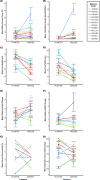Is it best to add native shrubs to a coastal sage scrub restoration project as seeds or as seedlings?
- PMID: 35134054
- PMCID: PMC8824352
- DOI: 10.1371/journal.pone.0262410
Is it best to add native shrubs to a coastal sage scrub restoration project as seeds or as seedlings?
Abstract
Ecological restoration frequently involves the addition of native plants, but the effectiveness (in terms of plant growth, plant survival, and cost) of using seeds versus container plants has not been studied in many plant communities. It is also not known if plant success would vary by species or based on functional traits. To answer these questions, we added several shrub species to a coastal sage scrub restoration site as seeds or as seedlings in a randomized block design. We measured percent cover, density, species richness, size, survival, and costs. Over the two years of the study, shrubs added to the site as seeds grew more and continued to have greater density than plants added from containers. Seeded plots also had greater native species richness than planted plots. However, shrubs from containers had higher survival rates, and percent cover was comparable between the planted and seeded treatments. Responses varied by species depending on functional traits, with deep-rooted evergreen species establishing better from container plants. Our cost analysis showed that it is more expensive to use container plants than seed, with most of the costs attributed to labor and supplies needed to grow plants. Our measurements of shrub density, survival, species richness, and growth in two years in our experimental plots lead us to conclude that coastal sage scrub restoration with seeds is optimal for increasing density and species richness with limited funds, yet the addition of some species from container plants may be necessary if key species are desired as part of the project objectives.
Conflict of interest statement
The authors have declared that no competing interests exist.
Figures




Similar articles
-
Seed dispersal limitations shift over time in tropical forest restoration.Ecol Appl. 2015 Jun;25(4):1072-82. doi: 10.1890/14-1399.1. Ecol Appl. 2015. PMID: 26465043
-
High precipitation and seeded species competition reduce seeded shrub establishment during dryland restoration.Ecol Appl. 2015 Jun;25(4):1044-53. doi: 10.1890/14-1110.1. Ecol Appl. 2015. PMID: 26465041
-
Post-fire regeneration strategies of Californian coastal sage shrubs.Oecologia. 1982 Jun;53(3):355-358. doi: 10.1007/BF00389013. Oecologia. 1982. PMID: 28311740
-
The cost and feasibility of marine coastal restoration.Ecol Appl. 2016 Jun;26(4):1055-74. doi: 10.1890/15-1077. Ecol Appl. 2016. PMID: 27509748 Review.
-
Revegetation through seeding or planting: A worldwide systematic map.J Environ Manage. 2023 Jul 1;337:117713. doi: 10.1016/j.jenvman.2023.117713. Epub 2023 Mar 21. J Environ Manage. 2023. PMID: 36958277 Review.
Cited by
-
The influence of native shrub density on bird communities in the southern drylands of California, USA.BMC Ecol Evol. 2025 Jul 1;25(1):63. doi: 10.1186/s12862-025-02410-x. BMC Ecol Evol. 2025. PMID: 40596875 Free PMC article.
References
-
- Stockwell CA, Hendry AP, Kinnison MT. Contemporary evolution meets conservation biology. Trends Ecol Evol. 2003;18: 94–101. doi: 10.1016/S0169-5347(02)00044-7 - DOI
-
- Kimball S, Lulow M, Sorenson Q, Balazs K, Fang Y- C, Davis SJ, et al.. Cost-effective ecological restoration. Restor Ecol. 2015;23: 800–810. doi: 10.1111/rec.12261 - DOI
Publication types
MeSH terms
LinkOut - more resources
Full Text Sources
Other Literature Sources

